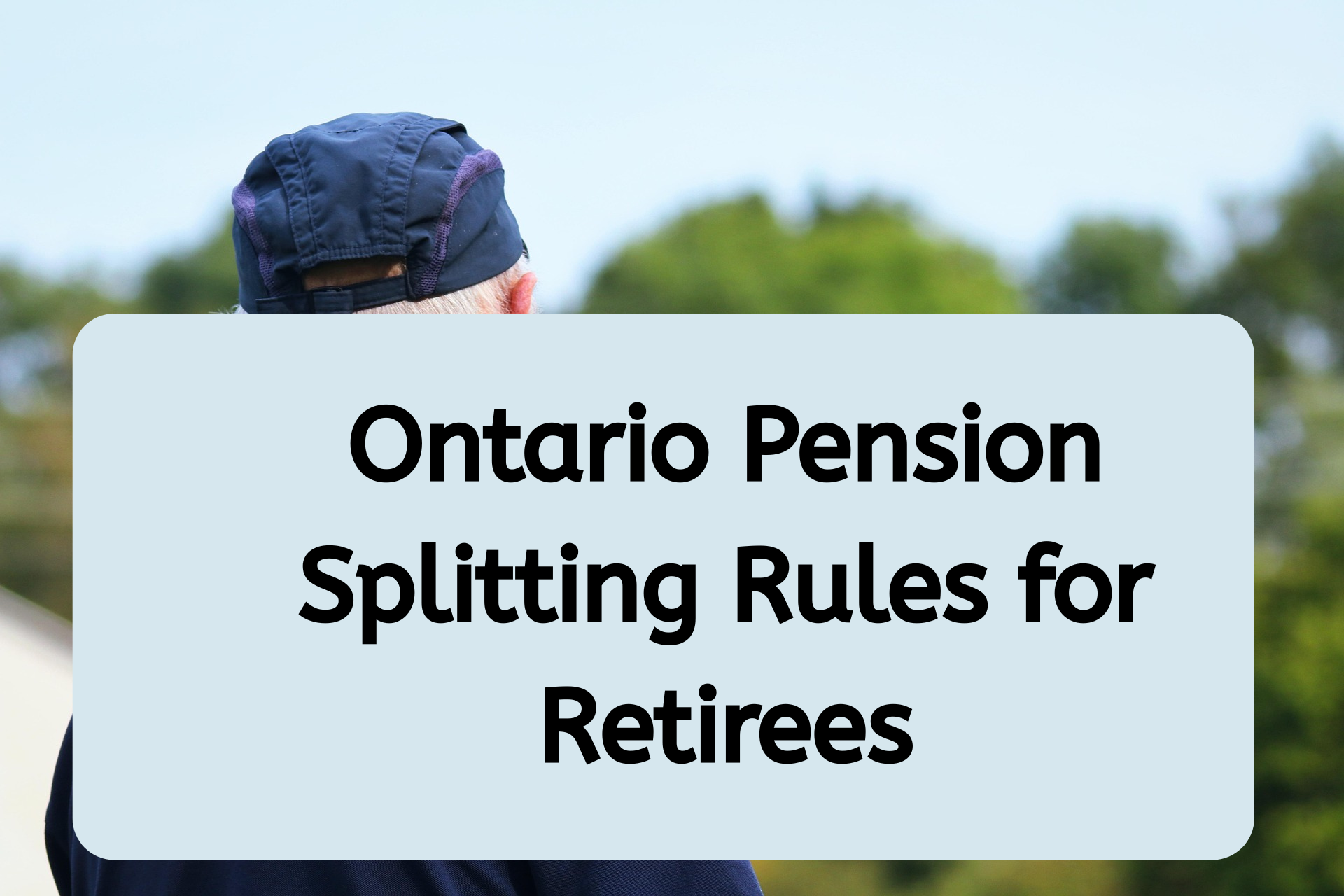Ontario Pension Splitting Rules for Retirees (Canadian Guide)

What Is Pension Splitting?
Pension income splitting is one of the most effective yet often overlooked — ways for Canadian retirees to reduce their household tax bill. It allows one spouse or common-law partner to share up to 50% of eligible pension income with the other partner for tax purposes.
In simple terms, it’s not about transferring money in your bank account — it’s about how your income is reported to the Canada Revenue Agency (CRA). The goal? To balance taxable income between partners so you pay less overall.
For example, if one spouse earns $70,000 in pension income and the other earns $10,000, splitting $30,000 could bring both partners into lower tax brackets, resulting in hundreds or even thousands of dollars in savings each year.
Why You Should Read This Section
If you’re nearing or already in retirement, understanding how pension splitting works could save you thousands in taxes — without changing your lifestyle or income.
This section lays the foundation for everything that follows in this guide. You’ll learn:
- The basic concept behind pension splitting (and how it really works)
- Who qualifies under Canadian tax law
- What kinds of pension income are eligible
- How to use CRA’s forms and deadlines correctly
Whether you’re working with a financial advisor or filing taxes yourself, having a clear grasp of pension splitting puts you in control of your retirement income strategy not the other way around.
Why Pension Splitting Matters for Ontario Retirees
Ontario retirees often face a mix of income sources company pensions, RRIF withdrawals, CPP, and sometimes part-time income. Without careful tax planning, that can push one spouse into a higher tax bracket, reduce Old Age Security (OAS) benefits, and trigger unexpected clawbacks.
Pension splitting helps smooth out those income differences, allowing couples to:
- Reduce their total taxes payable as a household
- Avoid or minimize OAS clawbacks
- Access age-related tax credits more easily
- Make retirement income last longer
For many Ontario couples, this is the difference between paying more to the CRA or keeping more for travel, hobbies, and healthcare in retirement.

Who Qualifies for Pension Income Splitting
Many Canadian couples approaching retirement are surprised to learn that they can legally share pension income for tax purposes and it’s not just for high-income earners. Pension splitting is open to a wide range of retirees in Ontario, provided you meet a few CRA rules.
Eligibility Requirements
To qualify, you must:
- Be a resident of Canada on December 31 of the tax year.
- Receive eligible pension income in that year.
- Have a spouse or common-law partner who is also a resident of Canada at the end of the year.
You can split up to 50% of your eligible pension income with your spouse. This can be a huge advantage if one partner is in a higher tax bracket allowing both to pay less overall tax.
Example:
Let’s say Paul receives a $60,000 annual pension and his wife, Linda, has $20,000 in retirement income. By splitting Paul’s pension income, they can even out their taxable income and potentially save thousands in taxes each year.
Types of Pension Income That Can Be Split
Not every retirement income stream qualifies for splitting. The CRA separates pension income into two categories: eligible and ineligible. Understanding this difference is key before filing your taxes.
Eligible Pension Income (Age 65 and older)
If you’re 65 or older, the following types of income generally qualify for splitting:
- Lifetime annuity payments from a registered pension plan (RPP)
- Withdrawals from a Registered Retirement Income Fund (RRIF)
- Annuities from a registered retirement savings plan (RRSP)
- Certain deferred profit-sharing plans (DPSPs)
This is the most common situation for Ontario retirees especially those who have converted their RRSP to a RRIF.
Eligible Pension Income (Under 65)
If you’re under 65, the rules tighten up. You can only split:
- Pension income from a registered company pension plan (e.g., from a former employer).
RRIF or RRSP withdrawals don’t qualify until you turn 65, unless they come from a deceased spouse’s plan.
Ineligible Pension Income
The following cannot be split:
- Old Age Security (OAS)
- Canada Pension Plan (CPP) or Quebec Pension Plan (QPP) benefits
- Guaranteed Income Supplement (GIS)
- Foreign pensions (unless taxable in Canada under a treaty)
- Investment income such as dividends or interest
Pro Tip: While CPP and OAS aren’t part of pension splitting, you can apply separately for CPP pension sharing, which is a different but similar tax-saving strategy.
Federal vs. Ontario Pension Splitting Rules
Here’s a point that often confuses retirees: pension splitting is not an Ontario-specific rule it’s a federal tax strategy available to all Canadian residents. However, your provincial tax (Ontario in this case) is calculated based on your split income, which means the benefit flows through to your Ontario tax return as well.
Federal Framework
The Canada Revenue Agency (CRA) oversees pension income splitting. It allows eligible retirees to allocate up to 50% of eligible pension income to their spouse when filing their tax return using Form T1032 (Joint Election to Split Pension Income).
Both spouses must sign and include this form with their tax returns.
Ontario Implications
Although Ontario doesn’t set its own pension-splitting laws, your provincial tax payable is directly affected by the income split. In other words, reducing your federal taxable income also lowers your Ontario provincial tax bill.
Here’s how it works:
- Lower combined taxable income = lower marginal tax rates
- Possible reduction in OAS clawbacks for the higher-income spouse
- Increased eligibility for Ontario senior benefits, such as:
- The Ontario Senior Homeowners’ Property Tax Grant (OSHPTG)
- The Ontario Energy and Property Tax Credit
- The Ontario Senior Homeowners’ Property Tax Grant (OSHPTG)
Example:
If a retired couple in Toronto splits $40,000 of pension income, their combined tax savings could easily reach $2,000–$3,000 per year, depending on their other income sources.
That’s money that can go toward healthcare costs, travel, or simply enjoying retirement without stress.
Step-by-Step: How to Split Your Pension Income
Now that you know you’re eligible and understand what counts as pension income, let’s walk through how pension splitting actually works step by step.
Think of this as your annual tax-time checklist for sharing pension income with your spouse or common-law partner.
Step 1: Confirm Your Eligibility
Before anything else, ensure both you and your spouse:
- Were residents of Canada on December 31 of the tax year.
- Have eligible pension income (as explained earlier).
- Are married or in a common-law relationship during the tax year.
If one partner passes away during the year, pension splitting may still apply but you’ll want to confirm with CRA or a tax advisor.
Step 2: Decide How Much to Split
You can split up to 50% of your eligible pension income.
This doesn’t mean you must split half it’s about finding the sweet spot where both spouses pay the least combined tax.
Pro tip: Use CRA’s online Pension Income Splitting Calculator or speak with a tax professional to test different scenarios.
Step 3: File CRA Form T1032
This is the official “Joint Election to Split Pension Income” form.
Here’s what to do:
- Both spouses must fill out and sign the form.
- Submit it with your tax returns (you don’t mail it separately).
- You can’t file this form unless both spouses agree on the amount to split.
Important: Pension splitting is done annually it’s not automatic from one year to the next. You’ll need to decide each tax season if it’s still beneficial.
Step 4: Avoid Common Mistakes
- Forgetting to sign both sections of the T1032 form
- Trying to split ineligible income (like OAS or CPP)
- Not keeping proper records or pension slips (T4A, T4RIF, etc.)
- Assuming it’s “set it and forget it”, it needs to be re-evaluated each year
Even a small oversight can delay your tax return or trigger a CRA reassessment.
Step 5: Reassess Each Year
Your financial situation changes over time especially after one spouse starts receiving CPP, OAS, or RRIF income.
Make it a yearly habit to check whether splitting still makes sense.
For many Ontario couples, the most significant savings come after both partners are retired, but before OAS clawbacks begin.
Tax Benefits of Pension Splitting for Ontario Retirees
Pension splitting isn’t just a clever tax trick it’s a legitimate tax-planning tool recognized by the CRA.
The main benefit is simple: reducing your combined household tax bill.
Here’s how the math and the logic work in your favour.
1. Lower Combined Tax Bracket
When one spouse earns significantly more than the other, that higher-income partner is taxed at a higher marginal rate.
By splitting pension income, you redistribute income to the lower-earning spouse, which:
- Reduces the higher spouse’s tax burden
- Uses up the lower spouse’s tax credits
- Keeps more money in your household pocket
Example:
If John earns $70,000 in pension income and his wife Mary earns $20,000, they can split up to $35,000.
John’s taxable income drops to $35,000, and Mary’s increases to $55,000, resulting in combined savings of roughly $2,500–$3,000 per year, depending on their credits.
2. Reduces OAS Clawbacks
Old Age Security (OAS) is reduced “clawed back” if your income exceeds $90,997 (2025 threshold).
By splitting income, you may bring one spouse’s income below this limit, protecting OAS payments from reduction or loss.
For many Ontario retirees, this is one of the biggest hidden perks of pension splitting.
3. Increases Eligibility for Senior Tax Credits
Pension splitting can also make you eligible for or increase certain federal and Ontario tax credits, such as:
- Age Amount Tax Credit
- Pension Income Amount Credit ($2,000 per person)
- Ontario Senior Homeowners’ Property Tax Grant (OSHPTG)
- Ontario Energy and Property Tax Credit
Balancing incomes allows both spouses to qualify for senior tax breaks, not just the lower-income partner.
4. Better Financial Planning and Budgeting
Even beyond taxes, pension splitting helps couples create predictable, balanced retirement income.
This stability can help when budgeting for major expenses like:
- Health insurance premiums
- Property taxes
- Home repairs or renovations
- Travel or leisure
It’s all about maximizing after-tax cash flow something every Ontario retiree values.
5. Example: Real-Life Ontario Scenario
Let’s look at a typical case.
A retired couple in Mississauga has:
- Husband: $68,000 in defined benefit pension
- Wife: $22,000 in RRIF withdrawals
By splitting $30,000 of his pension, their total tax savings come to around $2,900, and the husband’s income drops below the OAS clawback threshold saving another $400–$600 per year.
That’s more than $3,000 back in their pockets, just by ticking a box on their tax return.
If you’re an Ontario retiree or about to retire, pension splitting should be part of your annual tax planning.
It’s simple, CRA-approved, and can make a real difference in your retirement lifestyle.
Think of it as rewarding yourself for years of hard work by paying only the taxes you truly need to.
Impact on CPP, OAS, and RRSP Withdrawals
When it comes to pension income splitting, many retirees ask the same question:
Can I split all my retirement income, including CPP, OAS, and RRSP withdrawals with my spouse?
Canada Pension Plan (CPP)
CPP is handled a bit differently. You can’t “split” CPP through the normal tax election (Form T1032) instead, CPP has its own program called CPP Pension Sharing.
Here’s how it works:
- If you and your spouse/common-law partner are both at least 60 years old and receiving (or eligible to receive) CPP, you can share your CPP retirement benefits to even out incomes.
- The amount you can share depends on how long you’ve lived together during your working years.
Why it matters: CPP sharing can lower your total household taxes and sometimes even reduce your OAS clawback risk if one partner’s income is too high.
Tip: Apply for CPP pension sharing directly through Service Canada, not through your tax return.
Old Age Security (OAS)
Unfortunately, OAS cannot be split or shared. It’s an individual benefit based on your years of residence in Canada.
However, pension splitting can still indirectly protect your OAS from clawbacks.
If your personal income exceeds about $90,000 (2025 threshold), your OAS starts getting reduced.
By transferring up to 50% of your eligible pension income to your lower-earning spouse, you might stay below that clawback line preserving your full OAS payment.
RRSPs and RRIFs
Once you convert your RRSP into a Registered Retirement Income Fund (RRIF), the withdrawals become eligible pension income once you’re age 65 or older.
This means you can split up to 50% of your RRIF withdrawals with your spouse to reduce taxes.
If you’re under 65, RRIF withdrawals generally don’t qualify unless they come from a deceased spouse’s RRSP or RRIF.
Example:
Jim (70) withdraws $40,000 from his RRIF and his wife, Linda, has no pension income.
By splitting $20,000 of Jim’s RRIF income, both stay in lower tax brackets — and potentially save $2,000–$3,000 in taxes combined.
Common Scenarios for Pension Splitting
Let’s look at a few real-world examples Ontario retirees face when deciding on pension splitting.
Scenario 1: Married Couple with Different Income Levels
John receives a $60,000 company pension; his wife Mary has $10,000 in CPP and part-time income.
By splitting $30,000 of John’s pension, their household taxes drop, and John’s higher bracket is lowered.
Result:
They could save roughly $2,500–$4,000 per year in combined income taxes, depending on their exact situation.
Pension splitting is most effective when one spouse earns significantly more than the other.
Scenario 2: One Spouse Still Working, One Retired
Let’s say Susan retired early and draws her pension, but her husband Mike is still working.
In this case, splitting Susan’s pension income won’t help much it could even push Mike into a higher tax bracket.
Tip: Only split pension income when the receiving spouse’s tax rate is clearly lower otherwise, it can backfire.
Scenario 3: Retirees with Mixed Income Sources
Some couples receive income from several sources RRIF, CPP, OAS, and part-time work.
Strategically combining CPP pension sharing with pension income splitting and RRIF withdrawals can dramatically balance your taxable income.
A financial planner or tax professional can run projections to find your “sweet spot” the point where your combined taxes and OAS clawbacks are minimized.
Limitations and Risks
Pension splitting sounds great and for many Ontario retirees, it is but it’s not always the best move.
Here are some key limitations and potential pitfalls to keep in mind.
Not All Income Qualifies
Remember, only certain types of income count as “eligible pension income.”
For example:
- Yes: Company pension, RRIF income (65+), annuities from registered plans
- No: CPP, OAS, RRSP withdrawals before 65, investment income, or TFSAs
Always check CRA’s list of eligible pension income before filing your return.
Divorce or Separation
If your relationship ends, your pension-splitting arrangement also ends.
CPP pension sharing will stop, and tax-based pension splitting won’t apply for that year.
You may, however, still have to deal with pension asset division during a separation — an entirely different legal process.
Income Shifts and Tax Bracket Changes
If your income varies year-to-year for instance, due to capital gains, RRSP withdrawals, or property sales splitting might not produce the same benefit every year.
Always review your situation annually, since what saves taxes one year may not the next.
Filing Errors and Deadlines
Pension splitting must be elected jointly on CRA Form T1032, filed with both spouses’ tax returns.
If one spouse forgets or makes a mistake, CRA may reject the split.
You can request an adjustment later but it’s better to do it right the first time.
Pension splitting isn’t a one-time decision — it’s part of your yearly tax strategy. Review your income mix annually with a tax professional or advisor, especially as your RRSPs convert to RRIFs or your OAS begins. Small tweaks can mean thousands in tax savings every year.



